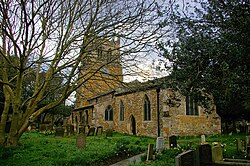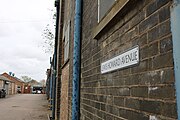Great Coates
| Great Coates | |
| Lincolnshire | |
|---|---|
 Church of St Nicolas, Great Coates | |
| Location | |
| Grid reference: | TA230099 |
| Location: | 53°34’19"N, 0°8’38"W |
| Data | |
| Population: | 1,464 (2011) |
| Post town: | Grimsby |
| Postcode: | DN37 |
| Dialling code: | 01472 |
| Local Government | |
| Council: | North East Lincolnshire |
| Parliamentary constituency: |
Great Grimsby |
Great Coates is a village in Lindsey, the northern part of Lincolnshire. It is to the north-west and adjoins the Grimsby urban area, and is served by Great Coates railway station.
The northern part of the parish extends to the shore of the Humber, and includes the chemical plants of Ciba, Grimsby and Tioxide, Grimsby.
Geography
The modern parish of Great Coates consists of a narrow strip of land around Woad Lane/Station Road running southwest/northeast with the railway station at the approximate centre. North-east of the strip, on the far side of the A180 road the parish expands to include the Moody Lane industrial estate, and the industrial plants of Novartis and the former Tioxide plant.
The land around Station Road/Woad Lane is in residential use, whilst the remainder of the parish is predominately industrial. The three main transport routes to Immingham: the industrial freight line to Immingham Docks (former Grimsby and Immingham Electric Railway), the Barton Line (former Great Grimsby and Sheffield Junction Railway, est.1845), and the A180 road pass through the parish. Urban and industrial development has made Greate Coates essentially contiguous with the town of Grimsby; the Grimsby suburbs of The Willows and Wybers Wood lie to the southeast and south respectively. To the west the land is mostly open countryside, in the civil parish of Healing.
At the 2001 Great Coates had a population of 1,111, increasing to 1,464 at the 2011 Census.
History
The earliest record of Great Coates is in the Domesday Book of 1086, with four associated entries. The manor included a church, mill, and 300 acre meadow. Taxed at 1.3 gelds, the manor comprised 6 villeins, 10 freemen and a priest.[1]
The Church of St Nicolas dates to around 1200 AD and was extended in the 13th century. Aisles and the chancel were added in the 1300s, the tower in the 14th or 15th century and, in the late 1700s, the clerestory and north aisle window were added. Restoration work took place in 1865, by James Fowler and, between 1929 and 1930, there were repairs to the roof and a new east window, with work undertaken by W. and L. Bond. The clockface, to the east, was made by Thwaites & Reed, and it dates to 1806.[2] The rectory to the church dates to the late Georgian period.[3]
There was a mediæval manor at the south end of the village, now evidenced by remains of the manorial moat. John Sandale, Chancellor of the Exchequer and Bishop of Winchester, held the manor of Great Coates and was granted Free warren there in 1313; Sandale's grant was 'to his heirs for ever' (et heredes sui imperpetuum).[4][5] Also granted in 1313 was the right to the manor's 'wreckage of the sea and all animals called waifs, found within the said manor' (wreccam maris et animalia que dicuntur waifes, in manerio suo predicto).[4][6] In October 1697 antiquary Abraham de la Pryme recorded the moated site in Great Coates as containing a brick built religious house, with "turrits like the old buildings, and somewhat in the walls of the walls of the gaithouse, which seems to have been niches for images, tho' now bricked up".[7]
In 1821, the parish of Great Coates comprised 171 residents and 46 houses,[8] The Manor Farmhouse is from the mid-18th century with later alterations; Cordeaux House, Cooks Lane, an estate house dating from 1820;[9] The Grange farmhouse, Rose Cottage, Station Road,[10] as well as four estate houses on Cooks Lane all dating from the early 19th century with later additions or alterations.[11][12]
The Great Grimsby and Sheffield Junction Railway was constructed around 1845, and Great Coates railway station was built in 1848.
In about 1887 the village consisted of the church, rectory]] (early 19th century, now 'The Old Rectory'[13]), a Wesleyan]] chapel, and around 20 dwellings including the substantial Manor House (built around 1878)[14]), and Great Coates House, as well as with the station less than 1/2 mile northeast of the traditional centre (church and manor site). Outside the village the parish was rural, with enclosed fields and drainage channels, with no other habitations of any significance, excluding Pyewipe farm to the north-east.
This development in the parish was mostly unchanged until 1950: the Grimsby and Immingham Electric Railway which passed through the northern part of the parish opened 1912; and terraced housing was built on Woad Lane north and south of the station in the early part of the century. Additionally a biscuit factory (Watmough and Sons Ltd) had been established east of Woad Road, and north of the railway line by the 1930s.[15] Watmough became part of Scribbans and Kemp in 1948 (later known as Kemps Biscuits, and later became part of United Biscuits).[16]
United Biscuits closed its factory in 1995, which then employed several hundred people.[17]
Today the Original Factory and Site is owned by HSH Coldstores who has developed and modernised the site into a Cold Storage Facility officially known as HSH Coldstores Lewis Howard Avenue. (Lewis Howard Avenue is the name of an internal access road built on the site in 2015).
After the Second World War the Humber Estuary bank between Grimsby and Immingham was industrialised. British Titan Products Co. Ltd. (later BTP Tioxide, closed in 2009) and CIBA Laboratories Ltd. established large chemical plants in 1949 and 1951 in the northern part of the parish, adjacent to the estuary (see Ciba, Grimsby, and Tioxide, Grimsby) The A180 road was built in the 1970s, and passes through the parish.
The urban spread of Grimsby reached Great Coates village by the 1980s with The Willows housing estate, and industrial estate development reaching the eastern edge of the village; the Wybers Wood estate had been built to adjoining the south of the village by the end of the 20th century. By the 1990s development of Grimsby had begun to extend beyond Great Coates, with the development of Grimsby's Europarc.
Pictures
|
Outside links
| ("Wikimedia Commons" has material about Great Coates) |
- "Great Coates Village Council". www.greatcoatespc.com. http://www.greatcoatespc.com.
- "The Parish of Great & Little Coates with Bradley – The West Grimsby Team Ministry". www.westgrimsbyteam.org/. http://www.westgrimsbyteam.org/.
References
- ↑ Coates Great Coates in the Domesday Book
- ↑ National Heritage List 1379843: Church of St Nicolas (Grade II listing)
- ↑ Nikolaus Pevsner: The Buildings of England: Lincolnshire, 1964; 1989 Penguin Books ISBN 978-0-300-09620-0
- ↑ 4.0 4.1 Baigent (1897, Preface, p.xix)
- ↑ Baigent 1897, p. 303)
- ↑ Baigent 1897, p. 303
- ↑ de la Pryme, Abraham (1870) [1683–1704]. The diary of Abraham de la Pryme [Emphemeris Vitae : Abrahami Pryme, or, A diary of my own life]. Surtees Society. p. 153. https://archive.org/stream/diaryabrahamdel00jackgoog#page/n198/mode/1up.
- ↑ Allen, Thomas (1834). The history of the county of Lincoln: from the earliest period to the present time. J. Saunders, Jr.. p. 245. https://archive.org/details/historycountyli01allegoog.
- ↑ National Heritage List 1379419: Cordeaux House (Grade II listing)
- ↑ National Heritage List 1379885: Rose Cottage (Grade II listing)
- ↑ National Heritage List 1379429: 19–22 Cooks Lane (Grade II listing)
- ↑ National Heritage List 1379355: The Grange (Grade II listing)
- ↑ National Heritage List 1379844: The Old Rectory (Grade II listing)
- ↑ National Heritage List 1379884: Manor Farmhouse (Grade II listing)
- ↑ "Watmough and Sons Ltd Biscuit Factory and Great Coates village, Grimsby, from the north-east, 1939". www.britainfromabove.org.uk. 9 August 1939. http://www.britainfromabove.org.uk/image/epw062578. Retrieved 24 August 2014.
- ↑ Peterson, Jay P., ed (2001). United Biscuits (Holdings) plc. 42.
- ↑ "United Biscuits blames lost jobs on snacks war". The Independent. 12 January 1995. https://www.independent.co.uk/news/business/united-biscuits-blames-lost-jobs-on-snacks-war-1567708.html. Retrieved 24 August 2014.
- National Heritage List 1379430: The Manor House, stables, coach house (Grade II listing)
- National Heritage List 1379431: Dovecote and adjoining stable range (Grade II listing)</ref>
- "Clee with Weelsby, Great Coates, Little Coates and Scartho". Local List of Historic Assets of Special Interest. North East Lincolnshire Council. 14 October 2013. http://www.nelincs.gov.uk/GetAsset.aspx?id=fAAxADYAMQAzADIAfAB8AFQAcgB1AGUAfAB8ADAAfAA1.
- Baigent, Francis Joseph (1897) (in English, Latin). The registers of John de Sandale and Rigaud de Asserio, bishops of Winchester (A.D. 1316–1323) : with an appendix of contemporaneous and other illustrative documents. Simpkin & Co. Ltd (London); Warren & Son (Winchester).. https://archive.org/details/registersofjohnd00cath.





